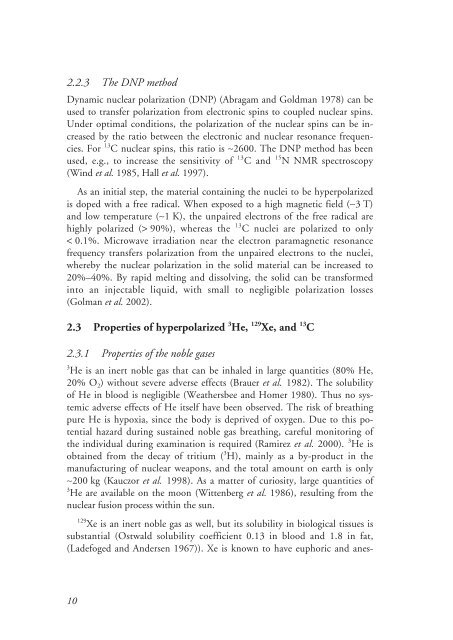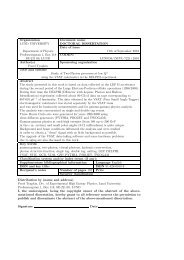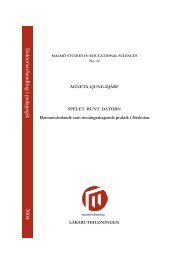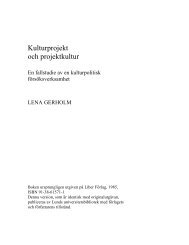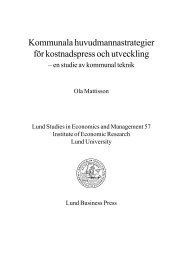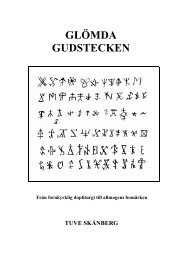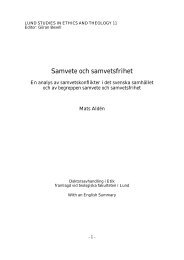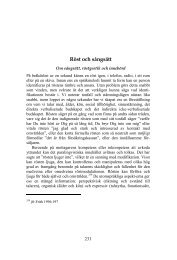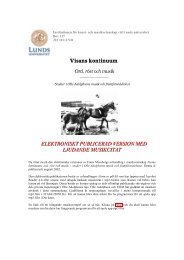Hyperpolarized Nuclei for NMR Imaging and Spectroscopy - Lunds ...
Hyperpolarized Nuclei for NMR Imaging and Spectroscopy - Lunds ...
Hyperpolarized Nuclei for NMR Imaging and Spectroscopy - Lunds ...
You also want an ePaper? Increase the reach of your titles
YUMPU automatically turns print PDFs into web optimized ePapers that Google loves.
2.2.3 The DNP method<br />
Dynamic nuclear polarization (DNP) (Abragam <strong>and</strong> Goldman 1978) can be<br />
used to transfer polarization from electronic spins to coupled nuclear spins.<br />
Under optimal conditions, the polarization of the nuclear spins can be increased<br />
by the ratio between the electronic <strong>and</strong> nuclear resonance frequencies.<br />
For 13 C nuclear spins, this ratio is ∼2600. The DNP method has been<br />
used, e.g., to increase the sensitivity of 13 C <strong>and</strong> 15 N <strong>NMR</strong> spectroscopy<br />
(Wind et al. 1985, Hall et al. 1997).<br />
As an initial step, the material containing the nuclei to be hyperpolarized<br />
is doped with a free radical. When exposed to a high magnetic field (∼3 T)<br />
<strong>and</strong> low temperature (∼1 K), the unpaired electrons of the free radical are<br />
highly polarized (> 90%), whereas the 13 C nuclei are polarized to only<br />
< 0.1%. Microwave irradiation near the electron paramagnetic resonance<br />
frequency transfers polarization from the unpaired electrons to the nuclei,<br />
whereby the nuclear polarization in the solid material can be increased to<br />
20%–40%. By rapid melting <strong>and</strong> dissolving, the solid can be trans<strong>for</strong>med<br />
into an injectable liquid, with small to negligible polarization losses<br />
(Golman et al. 2002).<br />
2.3 Properties of hyperpolarized 3 He, 129 Xe, <strong>and</strong> 13 C<br />
2.3.1 Properties of the noble gases<br />
3<br />
He is an inert noble gas that can be inhaled in large quantities (80% He,<br />
20% O2) without severe adverse effects (Brauer et al. 1982). The solubility<br />
of He in blood is negligible (Weathersbee <strong>and</strong> Homer 1980). Thus no systemic<br />
adverse effects of He itself have been observed. The risk of breathing<br />
pure He is hypoxia, since the body is deprived of oxygen. Due to this potential<br />
hazard during sustained noble gas breathing, careful monitoring of<br />
the individual during examination is required (Ramirez et al. 2000). 3 He is<br />
obtained from the decay of tritium ( 3 H), mainly as a by-product in the<br />
manufacturing of nuclear weapons, <strong>and</strong> the total amount on earth is only<br />
∼200 kg (Kauczor et al. 1998). As a matter of curiosity, large quantities of<br />
3<br />
He are available on the moon (Wittenberg et al. 1986), resulting from the<br />
nuclear fusion process within the sun.<br />
129 Xe is an inert noble gas as well, but its solubility in biological tissues is<br />
substantial (Ostwald solubility coefficient 0.13 in blood <strong>and</strong> 1.8 in fat,<br />
(Ladefoged <strong>and</strong> Andersen 1967)). Xe is known to have euphoric <strong>and</strong> anes-<br />
10


